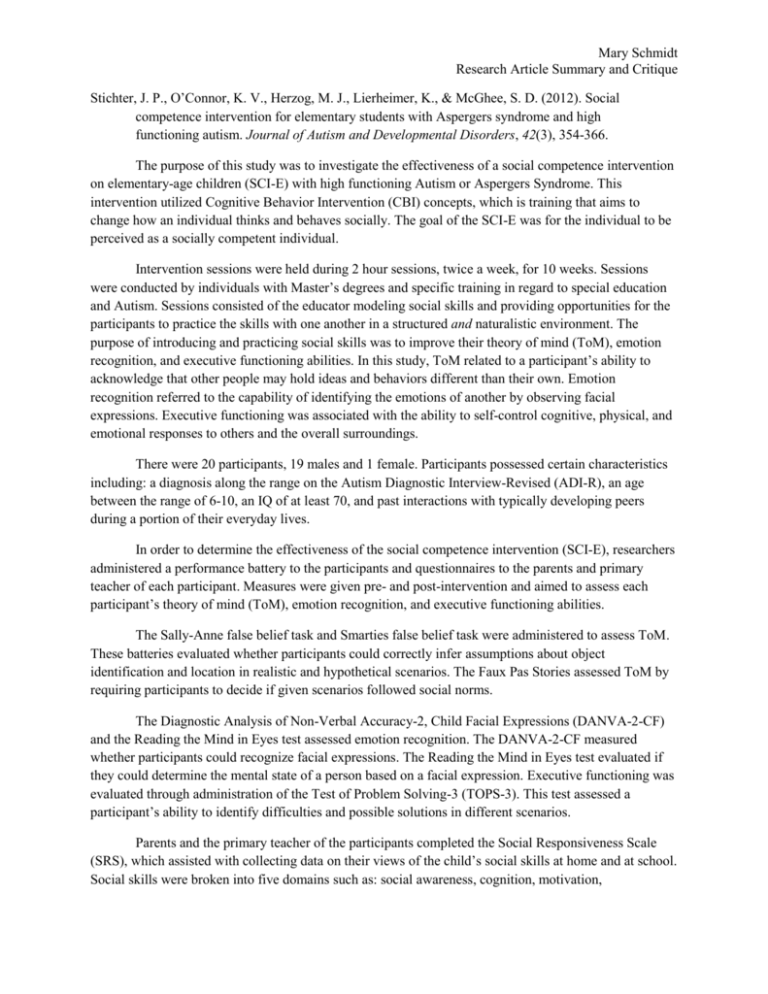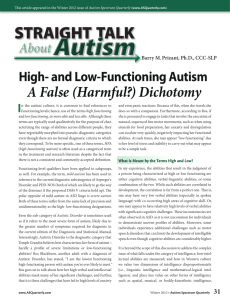Schmidt Article Summary and Critique
advertisement

Mary Schmidt Research Article Summary and Critique Stichter, J. P., O’Connor, K. V., Herzog, M. J., Lierheimer, K., & McGhee, S. D. (2012). Social competence intervention for elementary students with Aspergers syndrome and high functioning autism. Journal of Autism and Developmental Disorders, 42(3), 354-366. The purpose of this study was to investigate the effectiveness of a social competence intervention on elementary-age children (SCI-E) with high functioning Autism or Aspergers Syndrome. This intervention utilized Cognitive Behavior Intervention (CBI) concepts, which is training that aims to change how an individual thinks and behaves socially. The goal of the SCI-E was for the individual to be perceived as a socially competent individual. Intervention sessions were held during 2 hour sessions, twice a week, for 10 weeks. Sessions were conducted by individuals with Master’s degrees and specific training in regard to special education and Autism. Sessions consisted of the educator modeling social skills and providing opportunities for the participants to practice the skills with one another in a structured and naturalistic environment. The purpose of introducing and practicing social skills was to improve their theory of mind (ToM), emotion recognition, and executive functioning abilities. In this study, ToM related to a participant’s ability to acknowledge that other people may hold ideas and behaviors different than their own. Emotion recognition referred to the capability of identifying the emotions of another by observing facial expressions. Executive functioning was associated with the ability to self-control cognitive, physical, and emotional responses to others and the overall surroundings. There were 20 participants, 19 males and 1 female. Participants possessed certain characteristics including: a diagnosis along the range on the Autism Diagnostic Interview-Revised (ADI-R), an age between the range of 6-10, an IQ of at least 70, and past interactions with typically developing peers during a portion of their everyday lives. In order to determine the effectiveness of the social competence intervention (SCI-E), researchers administered a performance battery to the participants and questionnaires to the parents and primary teacher of each participant. Measures were given pre- and post-intervention and aimed to assess each participant’s theory of mind (ToM), emotion recognition, and executive functioning abilities. The Sally-Anne false belief task and Smarties false belief task were administered to assess ToM. These batteries evaluated whether participants could correctly infer assumptions about object identification and location in realistic and hypothetical scenarios. The Faux Pas Stories assessed ToM by requiring participants to decide if given scenarios followed social norms. The Diagnostic Analysis of Non-Verbal Accuracy-2, Child Facial Expressions (DANVA-2-CF) and the Reading the Mind in Eyes test assessed emotion recognition. The DANVA-2-CF measured whether participants could recognize facial expressions. The Reading the Mind in Eyes test evaluated if they could determine the mental state of a person based on a facial expression. Executive functioning was evaluated through administration of the Test of Problem Solving-3 (TOPS-3). This test assessed a participant’s ability to identify difficulties and possible solutions in different scenarios. Parents and the primary teacher of the participants completed the Social Responsiveness Scale (SRS), which assisted with collecting data on their views of the child’s social skills at home and at school. Social skills were broken into five domains such as: social awareness, cognition, motivation, Mary Schmidt Research Article Summary and Critique communication, and autistic mannerisms. Parents also completed the Behavior Rating Inventory of Executive Function (BRIEF) to determine the parent’s views in reference to their child’s executive functioning abilities of meta-cognition and self-regulation of behaviors. In conclusion, SRS questionnaires completed by the parents and primary teacher of the participants revealed significant increases in overall social aspects. Social cognition, social communication, and social motivation mainly improved post-intervention. In regard to ToM, scores on the Sally-Anne test and Smarties demonstrated mixed results, but the Faux Pas stories indicated significant improvements in determining social scenarios that did not reflect social norms. Results supported that participants significantly increased in their executive functioning abilities of metacognition and behavior management. Emotion regulation measurements did not yield significant improvements post-intervention. A major strength of this study was that the researchers utilized standardized procedures and measures in order to investigate the effectiveness of the SCI-E. These aspects increase the validity and reliability of the results. This suggests that consumers of the research can have more confidence in the implications of the results. On the other hand, a weakness of this research is that it had a limited number of 20 participants. The limited number of participants decreases the ecological validity of this study, because the findings reflect a small and concise sample population rather than an expansive sample that can be generalized to the overall population of children with ASD. Until research is conducted with more participants, clinicians are left questioning whether this intervention has an overall benefit for the majority of elementary-age children with ASD. Additionally, this study was conducted over a short period of time; therefore, the results do not provide information on whether significant improvements of emotion regulation would have occurred given more time. The shortened time frame also leaves the question of whether the intervention would have long-lasting improvements during their middle school, teen, and adult years. Future studies should administer the intervention for a longer period of time in order to provide further evidence in regard to emotion regulation improvement and long-term effects. This research was interesting and informative in relation to the effectiveness of a social competence intervention and its contributions to overall improvements of social abilities. Elementary-age children with ASD increased their abilities to identify and determine the emotional states of an individual by evaluating their facial expressions. Their ability to self-regulate behaviors also improved. As a future clinician, I believe this article was helpful. It supplied me with information about what interventions should focus on in order to improve the social skills of elementary-age children with ASD. Although more expansive research must be conducted on the elementary-age population, this study provides evidence that social competence intervention is effective for this age group. Additionally, prior research supports that social competence intervention is effective in improving the social skills of adolescents. Combining the findings of various research, clinicians have evidence that modeling and practicing social skills is effective in teaching children with ASD. This type of intervention should be utilized in schools and clinical settings, because it assists in improving their ability to infer what others are thinking and feeling as well as control their own behaviors in reaction to a variety of social situations.







